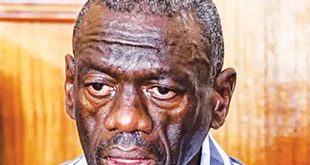
INEA
It sits astride the Kumi-Soroti highway. Prominent behind the low roofed shops is an oval-shaped structure towering above the bushy compound. This infamous protrusion is a monument at Okunguro Railway Station. It is a reminder of the rebellion where 55 victims of the bloody insurgency were finally laid to rest.
They were brutally suffocated to death in a train wagon after being accused by NRA (now UPDF) of supporting the then Uganda Peoples Army rebels. Locals say there are ghosts that sing in the trees at night.
Locals say Mukura is haunted by that black July 11, 1989 day.
‘Here as we sip millet beer we first spill some on the ground to appease the dead. One risks their wrath if we don’t do that’, says John Okodel, a resident. ‘We suspect these droughts, floods and famine are a result of having denied our people a decent burial.’

He dismissed the recent comment by minister for Disaster Preparedness, Prof. Tarsis Kabwegyere that the famine has hit Teso because the Iteso are lazy. Okodel argues that if that was the case, how then would Teso have been able to feed the rest of the country with potatoes, cereal seeds and cows to the extent that a meat packers factory was built in Soroti?
‘We saw Tarsis Kabwegyere eating a samosa worth Shs2,000 on television. That is money that can buy maize flour and beans to feed my entire family of six,’ lamented Okodel.
Earlier this year, while on a week-long tour of the sub-region to sensitise the people on poverty eradication, Museveni apologised for the delay in compensation for the families of the Mukura victims. While addressing a rally in Ngora, he announced that Minister for the Presidency, Beatrice Wabudeya, would handle the compensation.
Museveni also advised them to diversify their subsistence farming in order to maximise financial returns. He said they are sitting on ‘gold’ hidden in land. However, like Moses Kwapi in Akapolin in Ongino whose farm the president toured, many villagers have already embarked on planting Upland rice, rearing pigs, goats, chicken and restocking their cows.
The President urged them to emulate Kwapi and engage in commercial agriculture, join savings and co-operative societies where they can access low interest loans and to add value to their products.
‘But where is the UCB, Lint Marketing Board or Coffee Marketing Board?’ asked Okello Cuthbert, 64. Okello wondered how the president expects people to benefit when these institutions were privatised. He said that while in Kampala it’s the HIV/AIDS killing people, in Kumi it’s poverty.

A tour around Mukura trading centre is a revelation that the Iteso will not wait for manna to drop from the skies. They have turned the place into a food basket of sweet potatoes, pigeon pea beans, ground nuts, pigs and short- horned cows. Every two Thursdays is Okison (Market Day) when trucks come from other parts of the country and neighbouring countries
to buy agricultural produce.
People are coping with life, but talking about those bad old days triggers tears in many eyes of those who were old enough at that time. It is a reminder of when NRA soldiers rounded up 60 people and herded them into train wagons on suspicion of ‘siding’ with the UPA rebels. The soldiers set fire under the wagons and smoked the occupants to death.
‘We had to strip naked, then climb on each other to reach holes on the body of the cabin to breath in some air. I still see eyes of the dying roll white as they eventually collapsed,’ a survivor narrates.
The 55 bodies of those who died were then stuffed in two nearby manholes. They were later exhumed and accorded a decent burial where the monument stands.
One Aguti Christine, 38, who had been married for two weeks at the time, did not have a honey moon. Ederu, her husband was the residents who were rounded up from the villages of Orisai, Opegei, Odwarat, Akubui and Okwangami.
The soldiers asked them the rebels’ whereabouts and they would say ‘mame ajeni’ (I don’t know). This year it will be 20 years since the massacre occurred but Aguti says her memory is as fresh as if it happened yesterday.
‘That day the soldiers came at about 10:00am. They arrested and ferried us to Ajeluku Primary School where their commander was screening everybody and sorting out [suspected] rebels.’
She says they were then classified into students, civil servants and the elderly, who were all made to sit in different designated places. Later the students, women, and the elderly were released. The civil servants and youthful men were taken to Okunguro army base. They were locked up in a store before being taken to the wagon.
All that Aguti has in life is a mud-and-wattle grass-thatched hut, three chickens, a goat and a small garden of sweet potatoes.
Government instituted an inquiry into the massacre, but the findings have never been made public. The government’s failure to compensate the victims means the matter has never been laid to rest. The government partially compensated some victims, with Sh750, 000 for every family. They had been promised Shs2.5m.
Some families of the victims are not satisfied with the memorial secondary school the government constructed in Okunguro in honour of the victims. They say it has not benefited them.
Jane Ipalitai, now 44, years-old recalls the death of three of her teachers, Richard Edegu Okello, William Ediet and William J. Eswau.
If it was not for her school identity card which showed she was in Primary Seven, she too would be among the dead.
Veteran politician Cuthbert Obwangor told INEA: ‘It will be hard for NRM to get a vote here unless government compensates the victims, not just erecting brick walls of a monument overgrown with bush.’
****
Sourced from INEA
 The Independent Uganda: You get the Truth we Pay the Price
The Independent Uganda: You get the Truth we Pay the Price


